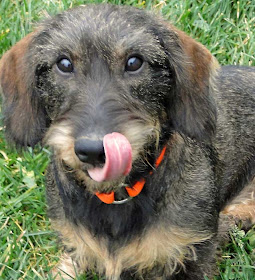
Karma's #7 recovery this season was a long exciting track. The hunter swore that he had a chest hit. He followed bright blood 100 yards to a bed and jumped the deer. After jumping the deer he followed blood for another 100 yards then lost the trail.
When Chris Martinek and I arrived we found paunch hair and bright blood at the hit site. We got off to a poor start due to many other deer in the area, walking on the same trails as our wounded buck. Eventually we followed our deer the 200 yards the hunter had marked. Then we added another 50 yards of trail out to a paved road. We lost the trail at the road. After 1/2 hour of searching we began to suspect a back track. Sure enough, when we went back we found blood spatters going back on the trail. Karma soon found the turn and took me through suburban door yards and across driveways. The hunter confirmed that we had tracking permission as we went from one property to another.
The trail was confirmed by an occasional drop of blood. After 1/2 mile the deer was veering to the west, away from the homes. Karma soon found a second bed. The blood leaving this bed was much fresher than the blood leading to it, so I knew we had jumped the deer. Now Karma was locked on to this deer. I knew that nothing could break her concentration. Rather than back off I decided to try to run the deer down. Away we went through swamp and thicket for over a mile. From time to time the trail was confirmed by a drop of blood. From time to time I would find a drop of blood with the fingers pointing back at us, indicating that the deer was moving in front of us and watching his back trail. In another 1/2 mile we were going through water nearly to the tops of my 18 inch pac boots. I took this to be a last ditch effort of a desperate deer trying to lose the trackers.
I was right. As we came out of the swamp and up a bank covered in rose, wood vine, and thorns, there lay our buck. He was still alive but his head was drooping as in sleep. The deer was 10 yards from Karma when I spotted him. I gave the hunter my dog lead and pruners to hold as I moved in for a killing shot. At 5 yards I cocked the hammer of my .44 mag. Hearing this the buck leaped to his feet and fled. The laser was on his chest so I squeezed.
The lucky bullet severed his spine, knocking him down and allowing me to dispatch him as humanely as possible.
Breathless, the hunter and tracker watched in celebration as Karma claimed her buck. We walked exactly 1 mile from where we dragged the buck to the road and the where the truck was parked. So, if we straitened out the trail we had probably tracked the deer from 1.5 to 2 miles. Maybe more.
The once skeptical, now totally impressed hunter, gave Deer Search a very generous donation.
Sorry about the poor quality picture. I had forgotten my camera and have to be content with a cell phone pic.
Kevin


















































